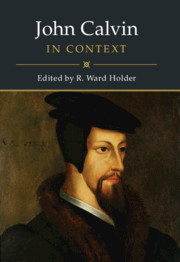Book contents
- John Calvin in Context
- John Calvin in Context
- Copyright page
- Dedication
- Contents
- Contributors
- Acknowledgments
- Abbreviations
- Introduction
- Part I France and Its Influence
- Part II Switzerland, Southern Germany, and Geneva
- Part III Empire and Society
- Part IV The Religious Question
- 19 Western Ideals of Religious Reform
- 20 The Luther Affair
- 21 Religious Colloquies
- 22 The Council of Trent and the Augsburg Interim
- 23 Biblical Scholarship
- 24 The Printed Word
- 25 Polemic’s Purpose
- 26 The Style of Theology
- 27 Baptism
- 28 The Eucharist
- 29 Predestination in Early Modern Thought
- 30 The Challenge of Heresy
- 31 Early Modern Christianity and Idolatry
- 32 Trinitarian Controversies
- 33 Nicodemism and Libertinism
- Part V Calvin’s Influences
- Part VI Calvin’s Reception
- Conclusion
- Bibliography
- Index
- References
33 - Nicodemism and Libertinism
from Part IV - The Religious Question
Published online by Cambridge University Press: 14 November 2019
- John Calvin in Context
- John Calvin in Context
- Copyright page
- Dedication
- Contents
- Contributors
- Acknowledgments
- Abbreviations
- Introduction
- Part I France and Its Influence
- Part II Switzerland, Southern Germany, and Geneva
- Part III Empire and Society
- Part IV The Religious Question
- 19 Western Ideals of Religious Reform
- 20 The Luther Affair
- 21 Religious Colloquies
- 22 The Council of Trent and the Augsburg Interim
- 23 Biblical Scholarship
- 24 The Printed Word
- 25 Polemic’s Purpose
- 26 The Style of Theology
- 27 Baptism
- 28 The Eucharist
- 29 Predestination in Early Modern Thought
- 30 The Challenge of Heresy
- 31 Early Modern Christianity and Idolatry
- 32 Trinitarian Controversies
- 33 Nicodemism and Libertinism
- Part V Calvin’s Influences
- Part VI Calvin’s Reception
- Conclusion
- Bibliography
- Index
- References
Summary
When Nicodemus approached Jesus under cover of night (John 3), he did so to keep from being seen with someone accused of taking liberties with Jewish tradition and morality. Both Nicodemus’s strategy and the associations he sought to avoid took on new forms in early modern Europe. Nicodemism was the practice of hiding one’s beliefs, usually to evade persecution. Libertinism included various forms of ethical indifference. Nicodemism and libertinism in the Reformation era are best understood in relation to the period’s profound cultural changes. A proliferation of new religious confessions in early modern Europe put many believers at odds with their communities. The resulting fluidity of religious identity meant that what one practiced did not always correspond with what one believed. More urgently, landing on the wrong side of belief could have disastrous, even deadly, consequences. The stakes were high at a time when religious pluralism was widely viewed as impurity that put a society under threat of divine judgment. Borders dividing mainstream from deviant religion could change quickly, so that a person found herself having to either prove she belonged or hide that she did not. Widespread persecution forced migration and exile upon those who could no longer worship according to their beliefs. Yet not everyone had the luxury of leaving for friendlier environs. Traditions of martyrdom and accusations of crypto-religion emerged within Catholic, Protestant, and radically reformed communities alike.
- Type
- Chapter
- Information
- John Calvin in Context , pp. 287 - 296Publisher: Cambridge University PressPrint publication year: 2019
References
Suggested Further Readings
- 1
- Cited by

